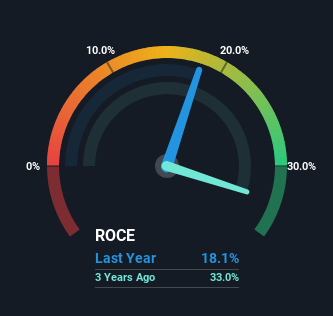To find a multi-bagger stock, what are the underlying trends we should look for in a business? Ideally, a business will show two trends; firstly a growing return on capital employed (ROCE) and secondly, an increasing amount of capital employed. Put simply, these types of businesses are compounding machines, meaning they are continually reinvesting their earnings at ever-higher rates of return. Although, when we looked at TOYA (WSE:TOA), it didn't seem to tick all of these boxes.
Return On Capital Employed (ROCE): What Is It?
Just to clarify if you're unsure, ROCE is a metric for evaluating how much pre-tax income (in percentage terms) a company earns on the capital invested in its business. To calculate this metric for TOYA, this is the formula:
Return on Capital Employed = Earnings Before Interest and Tax (EBIT) ÷ (Total Assets - Current Liabilities)
0.18 = zł87m ÷ (zł673m - zł193m) (Based on the trailing twelve months to June 2024).
Therefore, TOYA has an ROCE of 18%. In absolute terms, that's a pretty normal return, and it's somewhat close to the Consumer Durables industry average of 15%.
Check out our latest analysis for TOYA

Historical performance is a great place to start when researching a stock so above you can see the gauge for TOYA's ROCE against it's prior returns. If you'd like to look at how TOYA has performed in the past in other metrics, you can view this free graph of TOYA's past earnings, revenue and cash flow.
The Trend Of ROCE
On the surface, the trend of ROCE at TOYA doesn't inspire confidence. Around five years ago the returns on capital were 25%, but since then they've fallen to 18%. Meanwhile, the business is utilizing more capital but this hasn't moved the needle much in terms of sales in the past 12 months, so this could reflect longer term investments. It may take some time before the company starts to see any change in earnings from these investments.
On a related note, TOYA has decreased its current liabilities to 29% of total assets. That could partly explain why the ROCE has dropped. What's more, this can reduce some aspects of risk to the business because now the company's suppliers or short-term creditors are funding less of its operations. Since the business is basically funding more of its operations with it's own money, you could argue this has made the business less efficient at generating ROCE.
In Conclusion...
To conclude, we've found that TOYA is reinvesting in the business, but returns have been falling. Yet to long term shareholders the stock has gifted them an incredible 125% return in the last five years, so the market appears to be rosy about its future. But if the trajectory of these underlying trends continue, we think the likelihood of it being a multi-bagger from here isn't high.
TOYA could be trading at an attractive price in other respects, so you might find our free intrinsic value estimation for TOA on our platform quite valuable.
While TOYA isn't earning the highest return, check out this free list of companies that are earning high returns on equity with solid balance sheets.
Valuation is complex, but we're here to simplify it.
Discover if TOYA might be undervalued or overvalued with our detailed analysis, featuring fair value estimates, potential risks, dividends, insider trades, and its financial condition.
Access Free AnalysisHave feedback on this article? Concerned about the content? Get in touch with us directly. Alternatively, email editorial-team (at) simplywallst.com.
This article by Simply Wall St is general in nature. We provide commentary based on historical data and analyst forecasts only using an unbiased methodology and our articles are not intended to be financial advice. It does not constitute a recommendation to buy or sell any stock, and does not take account of your objectives, or your financial situation. We aim to bring you long-term focused analysis driven by fundamental data. Note that our analysis may not factor in the latest price-sensitive company announcements or qualitative material. Simply Wall St has no position in any stocks mentioned.
About WSE:TOA
TOYA
Produces hand and power tools, professional gastronomy, and home equipment in Poland and internationally.
Flawless balance sheet with solid track record.
Market Insights
Community Narratives



